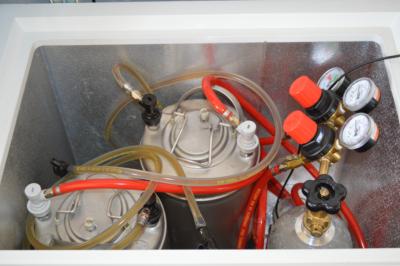Purpose
I started homebrewing beer in 2010, and I was quickly hooked on the process and the results. I found early that it was important to control the temperature during fermentation, and so I built a fermentation chamber with a Auber Instruments temperature controller. It works great: it provides both heating and cooling and is an effortless way to control the fermentation process. Another good, low-cost option is the so-called "eBay temperature controller" build detailed on homebrewtalk.com.
I bottled all my beers for a few years; I found that once I had the process down, it wasn't all that arduous. Nevertheless, corny kegs simplify the packaging process and open up new possibilites for containers (growlers, for example). So I finally took the plunge and upgraded to a kegging system.

Kegerator
A kegerator is a fridge dedicated to holding a pressurized keg (or kegs) of beer. I use a chest freezer, so "keezer" (keg/freezer) would be the more accurate term, but I will continue to use the generic "kegerator" throughout this site.
Arduino
Rather than go with an off-the-shelf temperature controller, I decided to do an Arduino-based build. I had heard of this microcontroller platform and knew people were using it even in academia, and I thought a hands-on project would be the best way to learn more. And when I learned that it would allow me to connect my kegerator to the internet of things via Twitter and the online graphing tools, that sealed the deal.
Continue to the build process or skip directly to the data visualization...